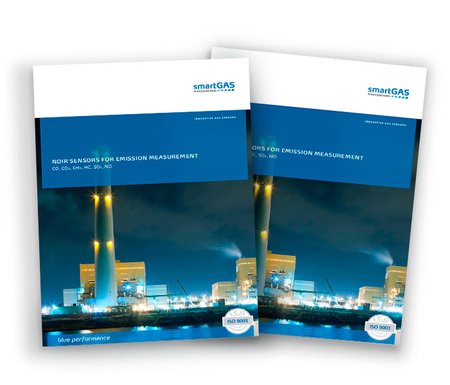CO sensors from smartGAS guarantee high-quality products
Carbon monoxide can be found in numerous industrial processes: It is produced for example as a by-product in cement production or as a synthesis gas during wood gasification. In this case it is the basis for further chemical processes such as the production of methanol or ammonia. To ensure that these processes remain efficient and comply with regulations, the CO concentration has to be monitored constantly.
CO sensors of the FLOWEVO series from smartGAS are ideal for this task: They operate on the basis of non-dispersive infrared (NDIR) absorption and therefore detect even minuscule carbon monoxide concentrations. The sensors are available for measuring ranges from 0 to 2000 ppm, 0 to 5000 ppm and 2, 10, 20, 50 and 100 Vol%.
Carbon monoxide measurement in the manufacture of cement
In the production of cement raw meal from calcium carbonate (CaCo3) is neutralised in a calcinator and then fired in a rotary kiln to produce clinker. The burner needed for this generally operates with a low-caloric fuel and tertiary air. This firing process generates large quantities of carbon monoxide. To assure compliance with the governmentally defined carbon monoxide threshold values, CO measurements must be conducted on a regular basis. CO sensors from smartGAS feature high-precision NDIR technology in order to quickly detect even small violations of the threshold values.
CO as a synthesis gas from the gasification of wood
In wood gasification an oxidant is used to convert wood to wood gas, which contains carbon monoxide. In combination with hydrogen, this is used as a synthesis gas for example in methanol production or in ammonia production. However, these gases can be produced only if the synthesis gas, consisting of carbon monoxide and water, has the optimal composition. This necessitates constant measurement and adaptation of the CO concentration.
CO emissions measurement in metal production
Carbon monoxide is also used for many chemical manufacturing processes, for example in the production of metals. Plants for the production of pig iron or steel, as well as iron foundries with a daily production of more than 20 tons discharge substantial quantities of carbon monoxide.
Large quantities of carbon monoxide are also generated in the production of aluminium. The gas forms when an aluminium oxide mixture is heated in an iron casting ladle, into which an anode consisting of graphite cylinders is submerged. During this process the positive carbon oxidises to form carbon monoxide and carbon dioxide.
Violations of CO threshold values must be reported
Metal manufacturing companies must submit an annual report of their emissions to the Federal Environmental Agency if they exceed a defined threshold value. However, this requires precise measurement of the carbon monoxide concentration. CO sensors from smartGAS are the first choice here, because they feature outstanding selectivity and low drift, in addition to very short response times.
CO sensors for process control in the plastic industry
Carbon monoxide also plays a major role in the plastic industry, where it is used as a synthesis gas in combination with hydrogen. In methanol synthesis, carbon monoxide and hydrogen first react with each other to form methanol. In the methanol-to-olefin reaction, the methanol is then converted to light olefins (alkenes) such as ethylene and propylene. Both are important raw materials for the production of plastic. Propylene is processed for example to produce polypropylene (PP) in the downstream polymerisation process.
Carbon monoxide is therefore an important gas for the production of thermoplastics, which are used to manufacture CDs, eyeglasses, sponges, dashboards and foams. The composition of the synthesis gas is crucial for the quality of the production process. Contaminations such as hydrogen sulphide, carbon black and nitrogen oxide must be removed from the gas to prevent damage to the converters needed for the subsequent production process. It is therefore very important to determine the exact CO concentration in the synthesis gas. CO sensors from smartGAS are ideal for this application, since their high sensitivity allows the precise measurement of the CO concentration in the synthesis gas.
smartGAS has the right CO sensor for your application!
Whether for use in metal production, the plastic industry or the production of cement: smartGAS has the optimal carbon monoxide sensor for your application!
Do not hesitate to contact our experts for a free consultation, at no obligation. We will be glad to assist you in improving the safety and efficiency of your processes!

